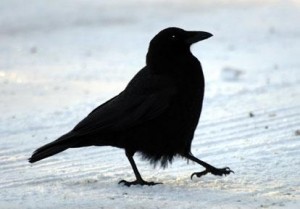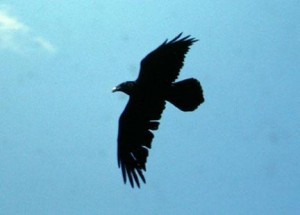American Crow, Mr. Wise Guy
- Share
- Tweet
- Pin
- Share
When people ask, “What is the best time to start birdwatching?” my immediate answer is “now.” It’s an especially appropriate reply in January in the North because there are so few species to have to learn.
Even people who claim absolutely no interest in birds know a crow and a sea gull, as clearly as black and white. Actually the crow, one variety or another, may be the world’s most familiar bird. About 30 species inhabit every piece of land with the exception of Antarctica, New Zealand, several oceanic islands, and the southern portion of South America. The official name of ours is the American Crow. Spend some time in Florida or along the southeastern U.S. coast, for example, and there you’ll enjoy the Fish Crow, slightly smaller and having a very un-crow-like voice, a high, nasal, single- or double-note cah-cah. Other crows you may see in our country are the Mexican Crow, Northwestern Crow, and naturally the granddaddy of the Corvus genus, the Northern Raven.
Depending on where your travels take you in the world, you will soon get to know the American, Carrion, House, Jungle, Black, Fish, Hooded or other crows. It is thought by animal behaviorists that the crow represents the pinnacle of avian evolution. Some species demonstrate social organization of a complexity unknown in the rest of the bird world. The Carrion Crow, thought to be the most advanced member of the crow family, is the sub-species that you’ll most likely experience in England, Wales, France, Germany, Spain or Portugal.
My most memorable crow experience dates back to a warm May day in the early 1940s when our junior high teacher had the windows wide open. The crows in the tall American Elm trees near the school were cawing constantly, making it terribly hard to concentrate on studying. I complained to my dad during the lunch hour at home, “Our teacher has the windows wide open, it’s so sunny and beautiful out and the crows are constantly mocking us with their cawing – how do the teachers expect us to concentrate on schoolwork?” I can imagine my dad’s perfect answer, “Do you suppose the crows are smarter than you?”
Henry Ward Beecher, famous U.S. clergyman of the 1800s, made the statement to the effect that if man could be feathered and provided with wings, very few would be clever enough to be crows! Anyone who has had a pet crow, downright mischievous in many ways, surely will agree to this claim.
We’re fortunate to be living in the country where we see and hear both the American Crows and Northern Ravens on a daily basis. Seen from a distance both are large black birds, difficult to tell apart. A raven’s four or five inches of extra length do not make its identification that much easier, especially from a distance. Naturally the raven’s low, guttural croaking and its profile while in flight, clearly showing its distinctive wedge shaped tail, compared to the crow’s slightly rounded shape, make identification easy.
It has been said, with tongue in cheek, that a raven has one more pinion in its outstretched primary flight feathers than the crow. However, telling them apart is still a matter of opinion. No doubt a crow’s response to that would be “CAAAW-ful!”
Study these omnivorous birds with the cast-iron-stomachs and you will be quite amazed at the wide range of food they consume, including many extremely injurious insects. The old Washington Biological Survey identified around 650 different items of food in their diet including eggs and nestlings of birds, up to and including larger species such as ducks and geese. It’s very easy to take sides against crows whereby this has led to the killing, using dynamite and poisoned bait, of thousands of crows in their nighttime roosts.
I banded songbirds for the U.S. Fish and Wildlife Service for 25 years, attended annual meetings around the Midwest, and was told by one of the biologists from the banding lab of an unusual and funny experience an Iowa farmer had with a crow. All bird banding years ago was under the direction of the Washington Biological Service. On each small aluminum leg band was included the abbreviation, “Wash Biol Surv. The engraving office blundered on one batch of bands and the abbreviation erroneously used was “Wash Boil Surv.” Story has it that the farmer shot a crow and eventually sent a letter to the banding division saying, “I shot this crow, and we followed your directions. My wife washed, boiled and surved it, and it was the toughest darn bird we ever ate!”
Crows tend to invariably be near the activities of people. Agricultural clearings for crops, as well as woodlots and tree plantings, especially in metropolitan areas where small park-like tree groupings have lured many crows to become “urbanized” birds. The unintentional kindness of people has helped the total crow population reach its greatest numbers in history. One factor which has led to the deaths of many of these well-known black birds has been the West Nile Virus. It is thought that the virus caused the fairly recent 80 percent drop in crows in a five-county region in northern Illinois. Other smaller birds, including Blue Jays, have also been affected.
I recall reading that the brain of a crow is larger in proportion to its body size than any other species of bird and, supposing that life on our planet ceased to exist in order of its intelligence, ability to find food and water, etc., the last relatively large creature to survive would be the crow.
I have great respect for the person who understands and appreciates the American Crow. It has occurred to other people in various places throughout history that, if animals were classified according to what they do rather than by physical characteristics, crows would be the most closely related to humans. This surely would give those wily black birds something to crow about!




